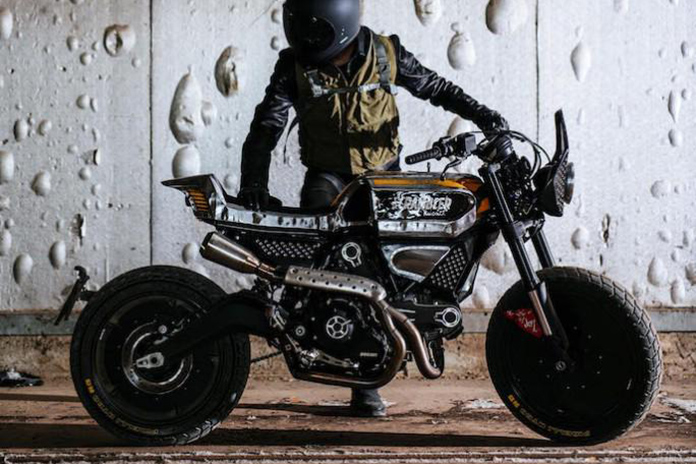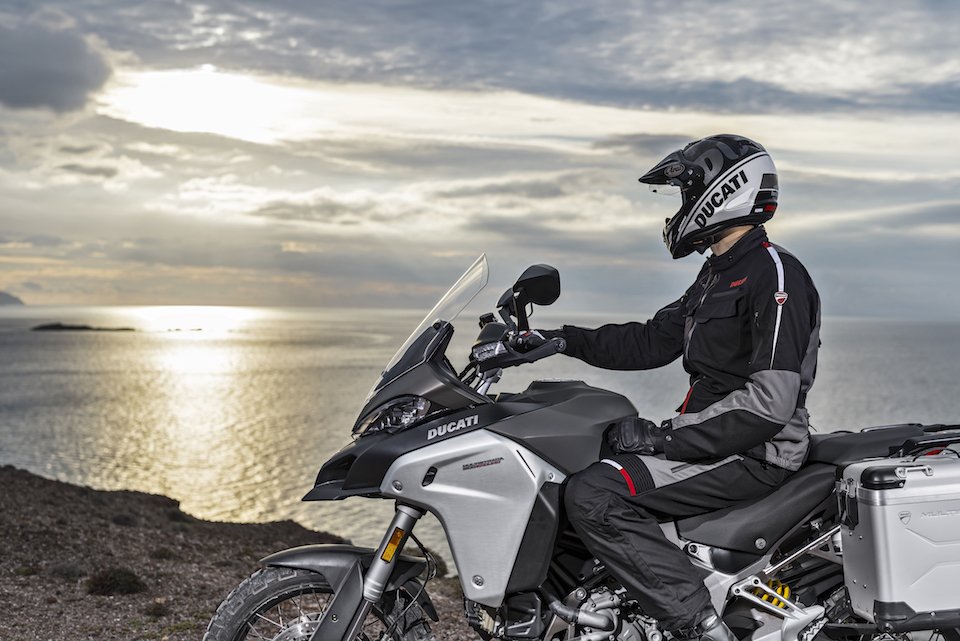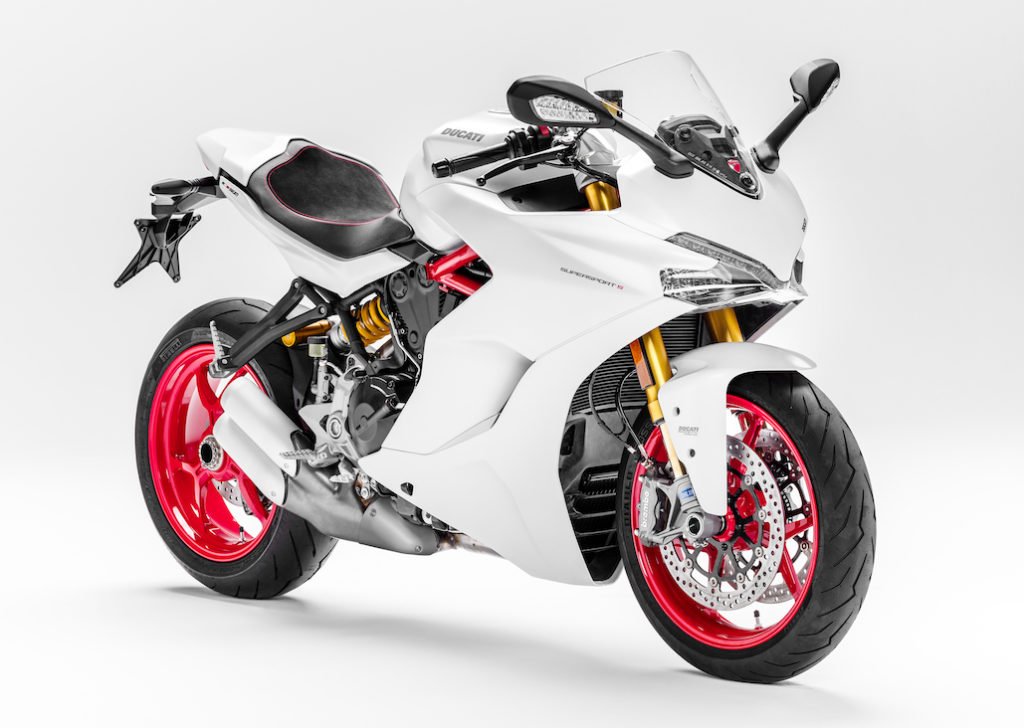Ducati Panigale R
 For 2015 Ducati also introduces the Panigale R, which is the homologated base for its World Superbike machines and is essentially a road-legal race bike with indicators and lights. Fitted with the 1198 cm3 Superquadro engine, thus falling within Superbike displacement limits, it boasts titanium intake and exhaust valves and rods, two-ring pistons and an extremely lightweight crankshaft which is balanced with tungsten inserts, to guarantee a maximum power of 205 hp at 11,500 revs/minute and a torque of 136.2 Nm at 10,250
For 2015 Ducati also introduces the Panigale R, which is the homologated base for its World Superbike machines and is essentially a road-legal race bike with indicators and lights. Fitted with the 1198 cm3 Superquadro engine, thus falling within Superbike displacement limits, it boasts titanium intake and exhaust valves and rods, two-ring pistons and an extremely lightweight crankshaft which is balanced with tungsten inserts, to guarantee a maximum power of 205 hp at 11,500 revs/minute and a torque of 136.2 Nm at 10,250
The new electronic kit, studied specifically for the Panigale and integrated in the three different Riding Modes, makes it even more high-performance. Thanks in fact to the presence of the Inertial Measurement Unit (IMU), Cornering ABS is made available, along with Ducati Wheelie Control (DWC). Moreover, the Ducati Quick Shift (DQS) now works also during down-changing, to further improve track performance and to make the bike more easy to use on a daily basis. On the Panigale, the Ducati Traction Control (DTC), Ducati Wheelie Control (DWC) and the Engine Brake Control (EBC) have been optimised by an automatic calibration system which allows for easy changes in tyre size and final drive ratio.
The Panigale R is also fitted with Öhlins mechanical suspension, an adjustable swingarm pivot and the same electronic technology as the 1299 Panigale, as well as a lithium ion battery which means a reduction in weight of over 2 kg, making it a total of 6 kg lighter than the 1199 Panigale R.
Overview
- Colour scheme
- Special “R” colour scheme with black wheel rims
- Features
- 1198 cm³ engine with Superbike derived components
- New electronic kit with Inertial Measurement Unit (IMU)
- Riding Modes (Race, Sport, Wet)
- Ducati Safety Pack (Cornering ABS, DTC)
- DWC, EBC, DQS up/down
- Automatic calibration system of the tyre size and final drive ratio
- Öhlins mechanical suspension (NIX30 fork, TTX36 shock absorber)
- Lightweight forged aluminium wheels
- DDA+ GPS and visualisation of lean angle
- Li-ion battery
- Auxiliary buttons to adjust DTC, DWC, EBC
- Adjustable Öhlins steering damper
- TFT instrumentation with indicator of lean angle
- Akrapoviç homologated full titanium exhaust
- Air filter with high permeability Sprint Filter P08
Racing DNA
Created for the enjoyment of the most demanding enthusiasts, the Panigale R has been developed through the experience of Ducati in the World Superbike Championship. Fitted with a race-spec version of the Superquadro 1198 cm3 engine which meets displacement restrictions enabling it to compete in world and national Superbike and Superstock series, the Panigale R incorporates numerous features adapted specifically for the racetrack.
Titanium exhaust valves and 2 ring pistons have been added to the Superquadro engine, which was already fitted with titanium intake valves and rods. The pistons’ short-skirt design and the use of only 2 rings (compression ring and oil ring) reduce their overall mass and friction. Added to this is an extremely lightweight crankshaft, which is balanced thanks to tungsten inserts in the counterweights, and dedicated camshafts which allow the Panigale R to reach a maximum power level of 205 hp at 11,500 rpm and a torque level of 136.2 Nm at 10,250 rpm.
The Panigale R is also fitted with a clutch designed specifically for racing as well as a series of technical features that ensure maximum performance even after long distances, considering the strict regulations on power unit quotas in races reserved for modified production bikes.
Reinforcing the incredible level of performance of the electronic kit, the Panigale R has been fitted with the same elements used on the 1299 Panigale. It has, for instance, the Inertial Measurement Unit (IMU) which commands the Cornering ABS, Ducati Wheelie Control (DWC), Ducati Traction Control (DTC), and Engine Brake Control (EBC), along with an automatic calibration system for tyre dimension and final transmission ratio. In addition, it includes the Ducati Data Analysis+ GPS (DDA+ GPS) system with lean angle visualization. The impressive provision of electronic devices also includes auxiliary buttons on the handlebars, as on race bikes, to regulate the DTC, DWC or EBC systems rapidly during track use.
The Panigale R is also fitted with Öhlins mechanical suspension and it has a steering angle of 24° and a swingarm pivot that can be adjusted among 4 positions. In addition it has dedicated steering offset geometry which advances the front axle by 5 mm compared to the 1299 Panigale and the 1299 Panigale S (with relative increment of the wheelbase distance from 1,437 mm to 1,442 mm), in order to further increase stability particularly in conditions of extreme track riding or racing.
The Panigale R is fitted with a number of parts made in carbon fibre and, thanks in part to the use of the approved Akrapovic titanium silencer and the extremely lightweight lithium ion battery, the Panigale R weighs 6 kg less than the 1199 Panigale R. The bike use also an air filter with high permeability Sprint Filter P08.
Electronic Technology
The Panigale provides a new benchmark for electronic systems. The highly advanced electronic kit is supported by the Inertial Measurement Unit (IMU) which measures acceleration in relation to three axes and calculates the bike’s angle of roll and pitch. The IMU has made it possible to increase the performance of the electronic kit, introducing Cornering ABS, Ducati Wheelie Control (DWC). For the first time, the Ducati Quick Shift (DQS) functions also for downshifts. Furthermore, the Panigale is equipped with the Ride-by-Wire (RbW) system, the Ducati Data Analyser (DDA+) and the Ducati Riding Modes, which interact differently with the Ducati Traction Control (DTC), the Ducati Wheelie Control (DWC), the Ducati Quick Shift (DQS), the Cornering ABS, the Engine Brake Control (EBC). The impressive provision of electronic devices also includes auxiliary buttons on the handlebars, as on race bikes, to regulate the DTC, DWC or EBC systems during track use.
Ducati Traction Control (DTC)
The DTC system, a great Ducati success story, has been perfected even further for the Panigale and entirely integrated in the electronic kit for all the versions. It makes use of the software logic created for the Ducati Corse models used by the World Champions of MotoGP and Superbike and provides a choice of eight profiles developed by a team of riders and professional test-riders.
The system, which can be accessed via the left handlebar switches and visualised on the TFT instrumentation, allows the rider to choose from among the eight available profiles – each one has been programmed to supply a tolerance value for rear-wheel spinning control from one to eight. Level eight provides maximum safety, activating at the slightest sign of spinning, with a greater level of interaction, while level one, aimed at only the most skilled riders, has greater tolerance and minimum intervention. The DTC system and the selected level are permanently visualised on the instrumentation, to remind the rider of the current level of interaction following any modification of the selected Riding Mode.
Ducati Quick Shift (DQS) up/down
The DQS system now offers up/down functionality, which makes it possible to change gears in both directions without using the clutch, for even quicker and more efficient shifts. The system includes a bi- directional micro-switch integrated into the lever mechanism which, each time the gears are activated, sends a signal to the ECU. The system works differently for upshifts and downshifts, interfacing with the engine control electronics to incorporate an auto-blipper function during downshifts. This enables the gears to mesh smoothly without any intervention on the part of the rider, and combined with the slipper clutch and EBC it facilitates seamless downshifts in full control, even during the most aggressive riding.
Ducati Wheelie Control (DWC)
DWC is a control system devised from Ducati’s experience in racing. Thanks to the IMU it uses an algorithm with a series of parameters such as speed, acceleration, lean and pitch angles, to calculate if the front wheel is lifted from the ground and by how much. According to the setting currently selected, the system intervenes by reducing power and torque levels in order to control the wheelie. Like DTC, DWC can be set to 8 different levels. The DWC system and selected level are permanently displayed on the instrument panel, to remind the rider of the current level of interaction following any modification of the selected Riding Mode.
Engine Brake Control (EBC)
EBC (Engine Brake Control) was perfected by Ducati Corse in order to help riders optimise the stability of their vehicle in extreme conditions and when entering a turn, during races for the MotoGP and Superbike world championships by balancing the force acting on the back tyre in situations of intense engine braking. The EBC monitors the position of the throttle valve, the selected gear and the deceleration of the crankshaft during extreme braking and it regulates, with great precision, the opening of the throttle activated by the Ride-by-Wire system to adjust the back-torque applied to the tyre. The EBC has three setting levels accessible from the instrument panel of the Panigale and integrated automatically into the three Riding Modes in order to assist the rider still further in an extraordinarily efficient way.
The Ducati Riding Modes
Introduced for the first time on the multi-award winning Multistrada 1200 in 2010, the Ducati Riding Modes marked a change in the world of motorcycle engineering, allowing the rider to choose between three pre-set modes to provide the perfect setup for each rider and all kinds of weather and road conditions. Each Riding Mode is programmed to modify the character of the engine and the settings of the suspension even on the move. The modes available are a combination of extremely advanced dedicated technologies.
Race Riding Mode
Selecting the Race Riding Mode, the rider can count on 205 hp, with direct throttle response and, on the S version, a specific racetrack setting for the suspension. The Race mode includes a predefined level of DTC, DWC, EBC and ABS set for maximum performance on the racetrack – only active on the front wheel, and with the Cornering function not engaged.
Sport Riding Mode
Selecting the Sport Riding Mode, the racetrack or road rider can count on 205 hp of delivery with a sports throttle response and, on the S version, a sports type setting of the suspension. In Sport mode, the predefined levels of DTC, DWC, EBC AND ABS are set for sports performance on the road. Control of back wheel lift when braking is activated and the Cornering function setting provides maximum performance when cornering.
Wet Riding Mode
The Wet Riding Mode provides the rider on road or race-track with 120 hp of delivery with a gentle throttle response and, on the S version, a setting of the suspension that’s optimised for conditions with little grip. The predefined levels of DTC, DWC, EBC and ABS are set to provide maximum safety, completely eliminating back wheel lift when braking and the Cornering function setting also provides maximum safety.
TFT Instrumentation
The TFT (Thin Film Transistor) instrumentation of the Panigale makes use of the most advanced technology in the field of data visualisation. The configuration of the colour display can be modified and it adjusts automatically to the selected Riding Mode in order to provide the clearest possible display of the information according to riding conditions and it even inverts the colours of the characters and the background in situations of very low visibility. The high definition instrument panel shows rpm between 1,000 and 12,000 on a display with a 90° angle at the far top left corner of the main screen, adding increasing luminous bars to the display as the engine increases in speed and enlarging the main digits of the index (from 1 to 12) one by one, when the corresponding value has been reached. In the lower part of the display, from left to right, the current state and/or the settings of the Riding Modes are shown while the right-hand part of the screen contains a gear indicator. When the Track visualisation mode is selected, for the first time, the lean angle is also displayed. If the Lap Time function is activated on the instrument panel, the highest speed and maximum lean angle of each lap are also shown when the individual times are visualised.
Ducati Data Analyser+ GPS (DDA+ GPS)
With the Ducati Data Analyser (DDA), which includes Mac-compatible software and a USB data recovery device, it’s possible to evaluate the performance of the bike and the rider, with graphic presentations for specific areas of data. The DDA+ GPS is the latest generation of the Ducati Data Analyser with GPS function and it automatically records the timing of each lap every time the Panigale crosses the finish line of a racetrack. When the rider, crossing the finish line, presses the high-beam flash button, this highly innovative system records the coordinates of the position and then records the timings of each successive lap once it’s been completed.
The DDA+, an essential instrument for race bikes, is able to record a wide range of data, including throttle, speed of the bike, selected gear, engine temperature, distance travelled, rpm and lap times. A new data collection channel has been introduced to record the DTC index, presenting it as a graphic line showing the level of interaction of the DTC in case of rear wheel spinning. The data can be downloaded after a ride out or a track session to compare and analyse the performance of both rider and bike in detail, including lean angles.














